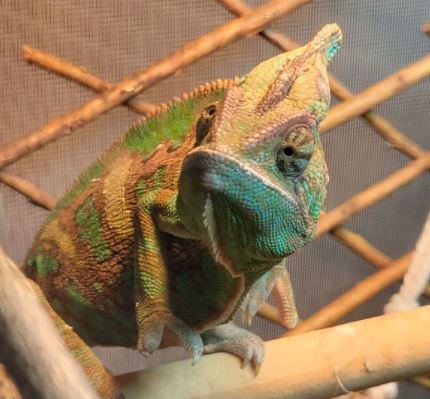How do chameleons drink water
How do chameleons drink water: Chameleons, with their captivating ability to change colors and unique physical attributes, have long intrigued both biologists and nature enthusiasts. These fascinating reptiles belong to the family Chamaeleonidae and are renowned for their remarkable camouflage capabilities, which allow them to blend seamlessly into their surroundings. With over 200 recognized species distributed across various parts of the world, chameleons exhibit an extraordinary range of adaptations that make them a subject of immense scientific interest.
Alongside their awe-inspiring color-changing capabilities and distinct physical features like independently moving eyes, prehensile tails, and zygodactyl feet (characterized by two toes pointing forward and two toes backward), chameleons possess another intriguing characteristic: they are masters of disguise.
The significance of water in sustaining life cannot be understated. Water is a vital resource that serves as the foundation for various biological processes.
For all living organisms, including humans and animals alike, water is essential for hydration, temperature regulation, digestion, waste elimination, and overall physiological functioning. Chameleons are no exception to this universal need for water; despite existing in drier habitats where water sources may be scarce or intermittent in availability.
However grand or minute an organism’s existence may be on this intricate web we call life; the necessity for water remains unyielding.
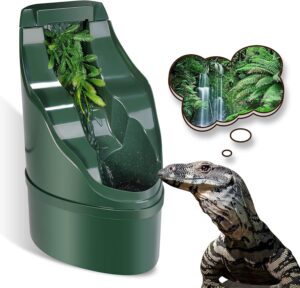 Chameleons’ reliance on water goes beyond mere survival – it plays a pivotal role in maintaining their health and well-being. From aiding digestion to regulating body temperature through evaporative cooling processes such as panting or thermoregulatory behaviors like basking under sunlight or seeking shade when necessary – access to water sources is crucial for chameleons’ day-to-day functioning. In addition to physiological requirements, moisture also plays a significant role in preserving skin health.
Chameleons’ reliance on water goes beyond mere survival – it plays a pivotal role in maintaining their health and well-being. From aiding digestion to regulating body temperature through evaporative cooling processes such as panting or thermoregulatory behaviors like basking under sunlight or seeking shade when necessary – access to water sources is crucial for chameleons’ day-to-day functioning. In addition to physiological requirements, moisture also plays a significant role in preserving skin health.
Chameleon skin, delicate and permeable, necessitates hydration to maintain its elasticity and prevent dehydration-related issues. Moreover, moisture is essential for shedding their skin during the molting process, allowing them to grow and replace old skin layers efficiently.
In light of the remarkable chameleon species diversity and their reliance on water for fundamental biological processes, delving into the intricacies of how these reptiles obtain and utilize water is a captivating journey that sheds light on their evolutionary adaptations. Understanding how chameleons drink water not only unveils their astonishing strategies but also provides valuable insights into the marvels of nature’s ingenuity in equipping creatures with means to conquer challenges posed by their unique environments.
Chameleon’s Natural Habitat
A Kaleidoscope of Environments
Chameleons, those captivating creatures renowned for their color-changing abilities and seemingly magical demeanor, inhabit a wide array of environments across the globe. From the dense rainforests of Madagascar to the arid savannas of Africa and even certain regions in Europe and Asia, chameleons have adapted to diverse ecosystems with remarkable efficiency.
Their natural habitats vary greatly depending on their species, but they all share an affinity for warm climates. One distinctive characteristic of chameleon habitats is their propensity for arboreal environments.
Many chameleon species are arboreal, meaning they dwell predominantly in trees. These tree-dwelling chameleons can be found perched gracefully on leaves and branches as they navigate their lush surroundings with astounding agility.
However, not all chameleons are adept climbers; some species have adapted to terrestrial or semi-terrestrial habitats instead. These ground-dwelling chameleons, while lacking the ability to scale heights with ease, possess fascinating adaptations that allow them to thrive in their chosen landscapes.
Water Availability: A Precious Resource
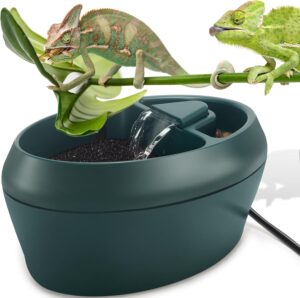 Water is a precious resource for all living organisms, and chameleons are no exception. However, water availability can significantly vary within different chameleon habitats due to various factors such as climate patterns and geographical features.
Water is a precious resource for all living organisms, and chameleons are no exception. However, water availability can significantly vary within different chameleon habitats due to various factors such as climate patterns and geographical features.
In rainforest environments where many chameleon species reside, rainfall plays an essential role in sustaining water sources. These tropical regions experience high levels of precipitation throughout the year, which results in abundant water availability for both arboreal and ground-dwelling species alike.
The dense foliage provides numerous opportunities for collecting rainwater along leaves or branches. On the other hand, semi-arid or arid regions pose significant challenges for water-seeking chameleons.
In these desiccated landscapes, water sources are sparse and ephemeral. Chameleons inhabiting such areas have adapted to rely on alternate means of hydration, such as dew or occasional rainfall.
The ability to efficiently utilize limited water resources is crucial for their survival, making their drinking techniques and adaptations all the more remarkable. Chameleons have evolved alongside their respective habitats, adapting to the unique challenges presented by each environment.
Whether it be the lush canopies of rainforests or the arid expanses of deserts, these incredible creatures have honed their abilities to procure water in various ingenious ways. In the following sections, we shall explore how chameleons detect and utilize available water sources through their remarkable physiological adaptations and drinking techniques.
Chameleon’s Thirst Sensing Mechanism
Chameleons, with their remarkable ability to adapt to different environments, have developed an intricate thirst sensing mechanism that enables them to detect the presence of water even in arid conditions. This mechanism is crucial for their survival, as water plays a vital role in various physiological processes within their bodies. Understanding how chameleons perceive and locate water sources provides valuable insights into their remarkable adaptation strategies.
Explanation of How Chameleons Detect the Presence of Water
A significant aspect of the chameleon’s thirst sensing mechanism lies in the specialized cells present on its skin that can sense moisture levels. These unique cells, called hygroreceptors, are intricately connected to the chameleon’s nervous system and serve as sensors for detecting humidity and moisture in its surroundings. The hygroreceptors operate similarly to human touch receptors, allowing chameleons to determine the presence or absence of water by assessing changes in moisture on their skin.
In addition to these specialized cells on their skin, chameleons possess a highly developed olfactory system that aids in detecting nearby water sources. Their ability to smell and locate water is incredibly acute, enabling them to scent moisture from several yards away.
This extraordinary olfactory capability is facilitated by sensory organs known as Jacobson’s organs located within the roof of their mouths. By flicking their tongues out and collecting air particles laden with scents from potential water sources, chameleons can precisely pinpoint nearby areas where they can quench their thirst.
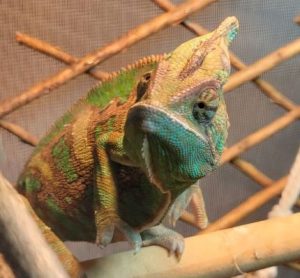
How Do Chameleons Drink Water: Drinking Techniques Adapted by Chameleons
Arboreal drinking method used by tree-dwelling chameleons
When it comes to quenching their thirst, arboreal chameleons have evolved fascinating techniques that make the most of their natural habitat. These tree-dwelling creatures primarily rely on rainfall and dew as their primary sources of water. As nimble climbers, they position themselves strategically on leaves or branches during rainy periods, allowing droplets to collect on the surfaces around them.
The chameleon’s specialized skin, equipped with capillary action channels, aids in absorbing these liquid droplets effectively. This ingenious adaptation allows them to derive hydration from the environment’s moisture-rich conditions.
Moreover, arboreal chameleons possess long and sticky tongues that play a significant role in accessing water present in tiny droplets on leaves or other surfaces. With lightning-fast reflexes and precise aim, they flick their tongues out towards the targeted water source.
The tongue adheres to the droplets through a combination of adhesion and suction forces before retracting back into the mouth. This effective mechanism enables arboreal chameleons to lap up even minuscule amounts of water with remarkable accuracy.
Terrestrial drinking method employed by ground-dwelling chameleons
In contrast to their arboreal counterparts, ground-dwelling chameleons face different challenges when it comes to accessing water sources. While rainfall is still a valuable resource for them, they exhibit an alternative approach for obtaining hydration.
After rainfalls or when puddles form naturally on the ground due to various factors like irrigation or seeping groundwater, terrestrial chameleons actively scan their surroundings for such water bodies. Once a suitable water source is located nearby, these astute creatures lower themselves close to it by extending their limbs downwards while maintaining a firm grip on the ground.
This positioning allows them to bring their mouths within reach of the water surface. Using their flexible tongues, ground-dwelling chameleons skillfully lap up the water present in these puddles or small bodies with precise and controlled movements.
It is worth noting that chameleons have evolved specific adaptations to ensure efficient drinking during this process. Their tongues are not only long but also possess a tube-like structure that enhances the speed and precision of water intake.
This specialized design enables them to maximize their drinking efficiency, ensuring they hydrate themselves adequately while minimizing any potential risks they may face on the ground. Chameleons exhibit remarkable versatility in their drinking techniques, adapting to their specific habitats and available water sources.
Whether they are arboreal chameleons harnessing moisture from rainfall and dew or terrestrial chameleons seeking out puddles or small bodies of water on the ground, these remarkable creatures have honed their abilities to procure hydration with great precision. By understanding these unique adaptations, we gain further insight into how chameleons navigate their environments and fulfill one of life’s most essential needs – staying hydrated amidst nature’s challenges.
Unique Adaptations for Water Conservation in Chameleons
Specialized skin structures that allow them to absorb moisture from various surfaces
How do chameleons drink water: Chameleons possess an array of remarkable adaptations that enable them to survive in arid environments where water scarcity is a common challenge. One such adaptation lies in their highly specialized skin structures, which play a crucial role in the absorption of moisture from various surfaces.
The skin of chameleons is not merely a protective barrier but also serves as a sophisticated mechanism for water conservation. It possesses microscopic channels that facilitate the absorption of liquid droplets through capillary action.
These minute channels, found all over the chameleon’s skin, function like tiny straws, drawing in and transporting liquid to deeper layers. Capillary action occurs when the adhesive forces between water molecules and the surrounding surface are stronger than gravity, allowing liquid to move against it.
This incredible ability enables chameleons to extract precious drops of moisture from dew-laden leaves or even rain-soaked surfaces. By maximizing their capability to absorb water through their skin, chameleons can efficiently utilize even minuscule available resources.
Capillary action: microscopic channels on their skin aid in absorbing liquid droplets
The process of capillary action relies on the intricate network of microscopic channels present on the chameleon’s skin. These tiny grooves create an expansive surface area across which water molecules can travel upward against gravity’s pull due to cohesive forces between them.
As a result, when a droplet touches the chameleon’s skin, it adheres and begins its journey through these intricate pathways. Moreover, this capillary system is not evenly distributed throughout the entire body surface but is particularly concentrated around areas where water collection is more probable, such as around scales or ridges on their backs and tails.
The strategic placement ensures maximum efficiency when encountering moisture, allowing chameleons to capture every available droplet. This adaptation significantly contributes to their survival in dry regions where water sources are scarce and unpredictable.
Hygroscopic scales: specialized scales that can absorb and retain moisture
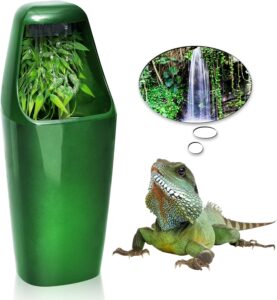 In addition to capillary action, chameleons possess another remarkable adaptation for water conservation: hygroscopic scales. These specialized scales have the extraordinary ability to absorb and retain moisture, further enhancing the reptile’s capacity to withstand periods of low water availability.
In addition to capillary action, chameleons possess another remarkable adaptation for water conservation: hygroscopic scales. These specialized scales have the extraordinary ability to absorb and retain moisture, further enhancing the reptile’s capacity to withstand periods of low water availability.
Hygroscopic scales are designed with tiny hair-like structures called setae, which greatly increase the surface area available for water absorption. When exposed to humidity or liquid sources, these setae actively trap moisture on their surfaces through molecular interactions.
The absorbed water is then stored within micro-pockets within the scale structure. This ingenious adaptation enables chameleons to carry a reserve of moisture with them even when they venture away from immediate water sources.
By efficiently retaining and utilizing this stored water, chameleons can prolong their survival during extended periods without access to fresh drinking water. Through their exceptional skin adaptations, including capillary action and hygroscopic scales, chameleons have evolved intricate mechanisms for conserving and utilizing precious water resources.
These remarkable features allow them to tap into even trace amounts of moisture present in their arid habitats. By capitalizing on every available droplet and efficiently storing acquired hydration, chameleons exemplify nature’s genius in adapting organisms to survive in challenging environments where sustenance is scarce.
Chameleon’s Water Intake Frequency and Quantity
Understanding the water intake frequency and quantity of chameleons is essential to grasp their unique adaptation strategies. Chameleons, being ectothermic creatures, are greatly influenced by their environment when it comes to hydration. Their drinking patterns are intricately linked to factors such as temperature, humidity, and the availability of water sources.
The frequency at which chameleons drink can range from daily to once every few days, depending on several environmental elements. In arid regions where water scarcity prevails, chameleons have evolved to conserve water efficiently.
They possess the ability to extract moisture from various sources like plants or dew-laden surfaces through their specialized skin structures. This adaptation allows them to supplement their hydration needs even in drier environments where standing water is scarce.
In contrast, chameleons inhabiting more humid environments with ample rainfall tend to drink more frequently. These species take advantage of rainfall and dew on leaves as their primary sources of hydration.
They exhibit remarkable dexterity in using their long and sticky tongues to lick droplets off surfaces or capture raindrops mid-air during heavy downpours. The combination of these strategies ensures that chameleons are well-equipped with an adaptive toolkit for acquiring water suitable for their survival.
To sum up how do chameleons drink water
Chameleons’ remarkable ability to adapt and survive in diverse habitats extends beyond their mesmerizing color-changing abilities; it encompasses the way they obtain this vital resource – water. Through a combination of physiological adaptations and behavioral flexibility, these fascinating creatures have developed mechanisms that allow them to thrive in both arid and humid environments. By understanding the intricacies of how chameleons drink water, we gain a deeper appreciation for the diversity of life on our planet and the complex ways in which different organisms have evolved to meet their specific needs.
It also serves as a reminder of the delicate balance that exists within ecosystems, where even the smallest of creatures play a crucial role. So, the next time you catch a glimpse of a chameleon delicately lapping up water droplets or blending seamlessly into its surroundings, take a moment to marvel at nature’s wonders and reflect on the incredible adaptations that allow these creatures to navigate their existence with grace and precision.
Further Reading:

